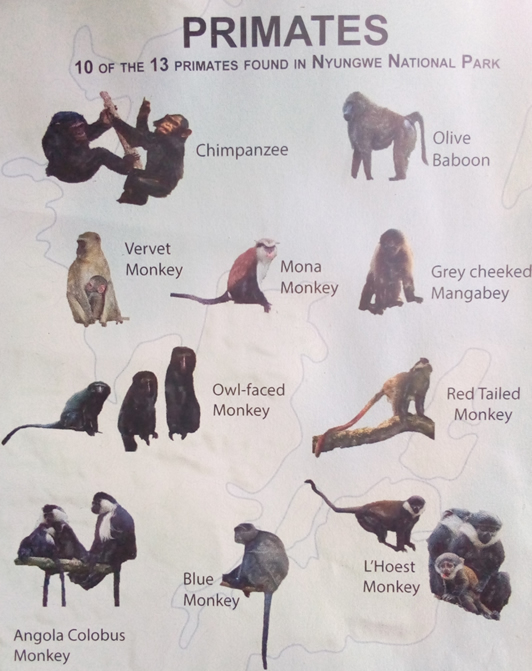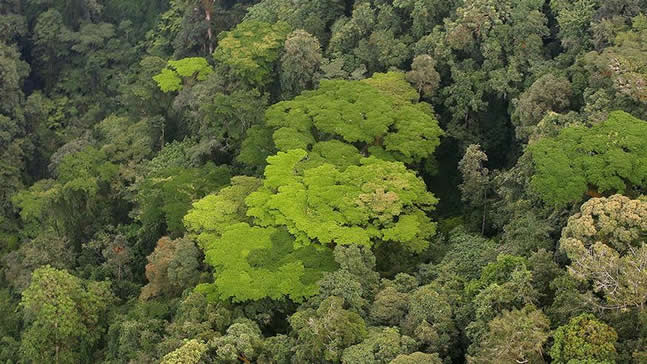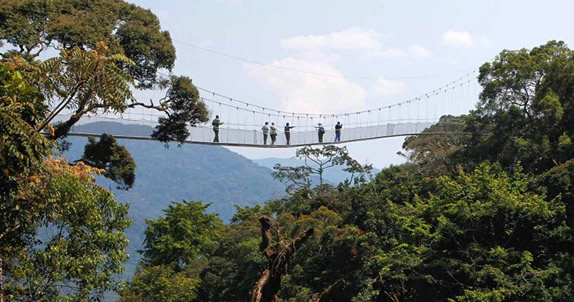Nyungwe Forest National Park – Rwanda
Nyungwe rain forest is placed in the southwestern Rwanda within the Albertine Rift Eco-region, at the border with Burundi to the south, and Lake Kivu and the Democratic Republic of the Congo to the west. It is located in the watershed between the basin of the river Congo to the west and the basin of the river Nile to the east. From the east side of the Nyungwe forest comes also one of the branches of the Nile sources.
Nyungwe rain forest is probably the best preserved rain forest in the mountains throughout Central Africa and is acclaimed for its bio-diversity and for being one of the most endemic species-rich areas I all of Africa.
The park covers 1020 km2 boosting diverse eco-system from rain forest, bamboo, grassland, swamps and bog habitats. It was established in 2004. The rain forest, bamboo, grassland, swamps, and bogs part of the park covers an area of approximately 970 km².
Attractions in the Park
The forest is situated in a region where several large-scale bio-geographical zones meet and the variety of terrestrial biomes, providing a great span of microhabitats for many different species of flora and fauna.
Wildlife
Nyungwe forest has a wide diversity of animal species, making it a priority for conservation in Africa.
The Primates
The park is renowned for its 13 different primate species that almost make 25% of Africa’s total. The primates of particular interest in the forest include colonies of the common chimpanzees and the Adolf Friedrich’s Angola Columbus (Columbus angolensis Ruwenzori) which is now extinct in Angola due to the intense hunt for which they were subjected.

The chimpanzees living in a community nearby Cyamudongo forest are about 500 in number while the Angola Colobus are about 400 that are inhabited in Nyungwe national park, making them the largest group in the world. The latter is easily recognizable from other monkey species due to its contrasting black fur and face, shoulders and tail tip surrounded by snow-white locks of hair.
Others primates include L’hoest Monkey that is the commonly spotted in troops of 8 – 20 individuals, Silver Monkey, blue monkeys related to the Golden Monkeys Virunga endemics, Hamlyn’s Monkey, Red-tailed Monkey that are soon facing extinction in this park and the Dent’s Monkey that is discreet and rarely seen. The Vervet Monkey that prefer open woodland areas, Olive Baboon, rarely seen secretive Owl faced monkey which is also an Albertine endemic with a stripe running from its nose to the lip giving it an own look living in the bamboo forest in the South of the park, and Grey-cheeked Mangabey.
There are also others that are shyful nocturnals such as the bush babies also known as the galago and the tail-less potto.
Other Mammals, Butterflies and Birds
There are also almost 310 bird species, 85 mammal species, 32 amphibian and 38 reptile species such as snakes, colorful lizards and 5 species of chameleon. Many of these animals are restricted-range species that are only found in the Albertine Rift montane forests eco-region in Africa. The park also comprise of hundreds of butterflies including 40 endemics to Nyungwe forest.
Vegetation
Nyungwe national park boasts of more than 240 tree species of which many reach 70 metres in height (upper canopy), 140 orchids and 1,068 species of plants that also include the giant Lobelia that is endemic to only the African Continent.

250 species of plants in the park are Albertine Rift Endemics. The South eastern section of the forest is fairly inaccessible due to the high density of bamboo plants.
Swamps also bring in distinctive vegetation with the largest marsh covering 13 square kilometers.
Tour Activities
Bird Watching:
Nyungwe is a home to 310 species of birds with 27 Albertine Rift endemics. Though it can quite be difficult spotting birds in the dense forest of Nyungwe where several bird species prefer to stay atop the canopy, guides provided for forest hikes will always be helping you in locating ad identifying these birds. Trails such as the Muzimu and the Kamiranzovu marsh with low lying vegetation give spectacular view points for different kinds of birds.
Forest Walks & Primates Tracking:
The top tour activity to the park. The rich diversity of primate life in Nyungwe Forest can be evidenced via nature walks following a number of trails. Some of these trails include the Karamba, a 4km 3 hours magnificent circular and easiest of all trails leading to spectacular view points of primates and birds and the Muzimu trail, a 5.2km 3.5 hours trail in the North East of the park offering particularly beautiful panoramic over the park and Lake Kivu.
Other trails include the Ngabwe trail that is 4.7km and takes about 3 hours passing near Mount Ngabwe leading through a variety of vegetation types as you frequently spot L’Hoest’s, Silver and Colobus monkeys, the Bigugu trail, Isumo/ waterfall taril, Congo Nile divide trail and the Source of the Nile Trail.
Canopy Walk

You can also go for a canopy walk on a walkway constructed on the Igishigishigi Trail. This leads through a 200m trail suspended between giant trees, offering magnificent views of the upper canopy of this tropical rain forest alongside spotting a number of birds for birding enthusiasts.
How to Get There
Nyungwe Forest National Park can be reached from Kigali, the country’s capital.
- Kigali > Muhanga> Nyanza > Huye, Nyamagabe > Park entrance.
From Kigali, Nyungwe Forest is approximately 225km which is about a 4 – 5 hours’ drive. Enroute, you can see/ breakoff to visit the Nyanza King’s palace, Natioanl museum, Intore dancers, craft shops, the arboretum, Cathedral in Huye and Gikongoro’s Genocide Memorial among others.
However, although the road to Huye is good, there are many sharp turns and winding areas meaning you should promptly follow the traffic rules and regulations.
Accommodations
Some of the facilities where you can sleep while in Nyungwe National park include.
- Luxury: One and Only Nyungwe house
- Mid-Range: Nyungwe top-hill hotel
- Budget: Gisakura Guest House

